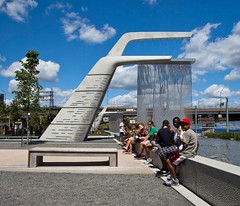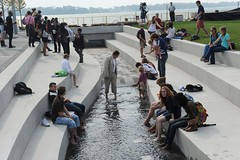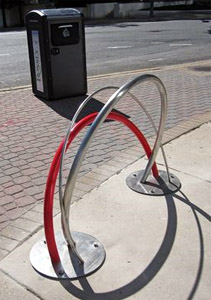|
Special Features





Image Libraries


|
|
Blog
I love a good water feature. Somehow, fountains just make parks and plazas better. So I was interested to read about Sherbourne Common, a new park in Toronto that’s centered around an architecturally and ecologically innovative series of water features.
The park doubles as a stormwater treatment plant. It collects runoff water from around Toronto, runs it through an ultraviolet cleansing processor that purifies it, and then routes it through a series of interesting fountains before releasing it into Lake Ontario.
Turns out the park is one of the centerpieces of a large waterfront redevelopment, not unlike DC’s efforts along the Anacostia River. It seems that urbanistically, Sherbourne Common is pretty comparable to Yards Park.
Here are some pictures, from the City of Toronto’s image gallery.
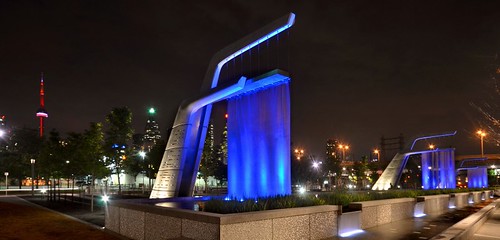
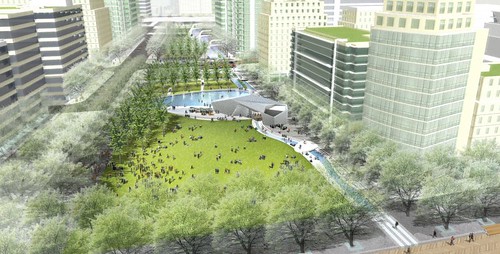
Average Rating: 4.4 out of 5 based on 298 user reviews.
September 2nd, 2011 | Permalink
Tags: architecture, environment, galleries, urbandesign

|
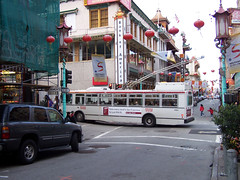
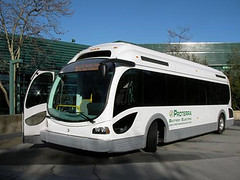
Above: A traditional electric trolley bus in San Francisco.
Below: GM’s wireless electric bus prototype. |
Electric buses offer many advantages over traditional fossil fuel buses, but they are more expensive and difficult to run. A new model by General Motors may bring them to the mainstream.
The most obvious advantage of electric buses is environmental, but the fact that they don’t spew any harmful gases into the atmosphere is hardly the only benefit. Electric buses are also quieter and smoother to ride than fossil fuel buses, resulting in a more comfortable experience for riders and fewer negative effects to the neighborhoods buses travel through.
Traditionally to run an all electric bus a transit agency had to install overhead wires. This can actually be an advantage as well, since it displays a sense of permanence to the transit line, which gives trolley buses some of the same economic development advantages of actual trolleys. On the other hand, wires can also be a big negative, both visually and fiscally. Installing and maintaining overhead wires adds so much to the cost of running a transit line that very few cities in the US use them.
But what if it were possible to run an electric bus without the wires? You’d lose that permanence advantage, but the environmental, comfort, and noise advantages would all still apply. And if, after all, wireless streetcars are being developed, why shouldn’t a wireless bus be possible too?
It turns out General Motors is working on one, along with a company called Proterra. Their EcoRide BE-35 model bus is fully electric and runs on lithium-ion battery packs that give it a 40-mile range for every 10-minute charge. The 35-foot, low floor bus design is basically comparable to normal city buses otherwise.
The website doesn’t include details such as whether the bus can run air conditioning (certainly a requirement in a muggy place like Washington), but if they can make the idea work it has potential to revolutionize urban busing.
 Cross-posted at Greater Greater Washington. Cross-posted at Greater Greater Washington.
Average Rating: 4.9 out of 5 based on 229 user reviews.
June 17th, 2011 | Permalink
Tags: bus, energy, environment, transportation

Memo to everyone who thinks the 5¢ plastic bag tax is about raising revenue: IT’S NOT ABOUT THE MONEY! The point of the tax is to discourage use of plastic bags, NOT to raise revenue. The less revenue the tax brings in, the better it is working. Seriously, this is not hard to understand.
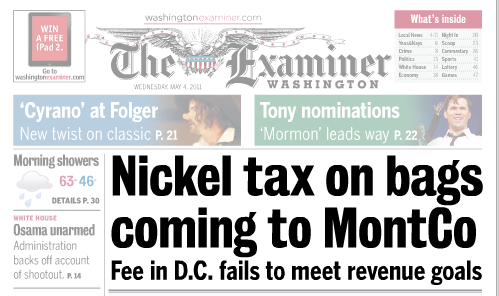
The Examiner completely misses the point with this headline.
To be fair, the online story is pretty is much on-target.
Average Rating: 4.9 out of 5 based on 158 user reviews.
May 4th, 2011 | Permalink
Tags: environment, government

Last in this week’s series of simple DC maps: city topography.
Interesting features that are clearly visible include Capitol Hill, Rock Creek gorge, the Anacostia bluffs, the floodplain escarpment at the north end of the L’Enfant city, the heights of Tenleytown (culminating at Fort Reno for DC’s highest point), and a large hill near the US Soldiers’ Home that I’m sorry to say I can’t name.
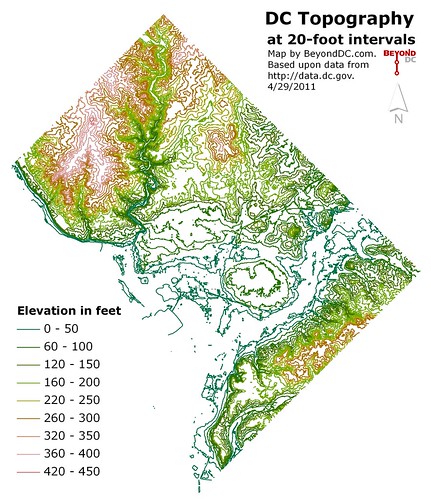
Click the map to enlarge.
Average Rating: 5 out of 5 based on 294 user reviews.
April 29th, 2011 | Permalink
Tags: environment, galleries

|

Radiation doses from a variety of sources.
Image from xkcd.com. |
Question: How might the disaster in Japan kill thousands of Americans? Answer: If anti-nuclear knee-jerk reactionaries are successful in using the Japanese tsunami as political leverage to scare Americans from investing in more nuclear power.
How so? Because every year 30, 000 Americans die from causes related to coal power production. Thirty thousand. That’s more dead Americans every year than in the entire Revolutionary War. It’s five times as many dead Americans as the Iraq and Afghanistan Wars combined. It’s almost twice the 18, 000 estimated Japanese dead from the tsunami disaster.
The longer we use coal instead of nuclear for the majority of our power generation in this country, the more Americans will die.
While we’re on the subject, let’s also talk about how dangerous the nuclear situation in Japan actually is. The chart at right is a snippet from a much larger one comparing radiation doses received for a variety of events. Note that the additional radiation doses received by Japanese citizens in villages near the breaking-down nuclear plant average less than a normal day’s dose (which is to say, they’re getting less than twice the normal daily dose that you get simply by living on the surface of the Earth). They’re less than you get from a dental x-ray, and much less than you get by flying on a jet from New York to Los Angeles.
It’s true that a relatively small number of workers at the plant are getting much higher doses, but the danger to the mass population is quite low. Meanwhile, thousands of people around the world continue to die every day as a result of coal power production. Far more than will ever die as a result of nuclear radiation from any of these Japanese plants. The 30, 000 American deaths per year attributed to coal average to more than 80 per day, which is nothing compared to the average of almost 1, 400 per day from China’s half-million annual coal deaths.
I don’t mean to imply that we should treat nuclear power lightly. Of course the only reason it’s so safe is that tremendous safety measures are involved. We should absolutely learn from the disaster in Japan to improve safety however possible. But one thing we cannot afford to do is allow knee-jerk reactionaries to stop America from expanding our nuclear production capacity. The human toll of such narrow thinking would simply be too great.
Average Rating: 5 out of 5 based on 246 user reviews.
March 21st, 2011 | Permalink
Tags: energy, environment, history

|

Might glowing trees like in the movie ‘Avatar’ soon illuminate our cities? |
Now here is a fascinating story:
Taiwanese researchers have come up with the elegant idea of replacing streetlights with trees, by implanting their leaves with gold nanoparticles. This causes the leaves to give off a red glow, lighting the road for passersby without the need for electric power.
It gets better:
This ingenious triple threat of an idea could simultaneously reduce carbon emissions, cut electricity costs and reduce light pollution, without sacrificing the safety that streetlights bring… In an added bonus, the luminescence will cause the leaves’ chloroplasts to photosynthesize, which will result in more carbon being captured from the air while the streets are lit.
I don’t think street lights are near the top of anyone’s hit list for ugly urban clutter. In fact, many can be quite lovely. But I have to admit the prospect of cities that look like the glowing forests from ‘Avatar’ thrills my imagination.
Could it actually work? The article is sparse on details. How much does it cost to do this? What do the glowing trees actually look like? Would they reproduce? Does it still work in winter when the leaves have fallen off? I can think of a hundred reasons why this might never be applied to cities on a large scale, but what if it’s so crazy that it actually works? And what else are the mad scientists of the world dreaming up?
Average Rating: 5 out of 5 based on 230 user reviews.
November 16th, 2010 | Permalink
Tags: environment, fun, urbandesign

|

Much larger ships will soon be able to sail through Panama, increasing traffic at east coast ports. |
I live-tweet the monthly meeting of the Transportation Planning Board. This month there were a number of items that I think folks might like to see in more-than-140-character detail:
- The Board reviewed and accepted the first-ever National Capital Region Freight Plan (pdf), which discusses rail and trucking issues in the region. When the Panama Canal expansion project is completed in 2015, it will dramatically expand the tonnage of material shipped to east coast ports from Asia, which in turn means the amount of freight carried inland from ports like Norfolk and Baltimore will dramatically expand as well. To deal with this expected increase and still accommodate passenger rail, regional rail providers are working to expand their capacity any way they can. These strategies are discussed in the report.
- Each year the TPB provides a series of planning grants to local jurisdictions aimed at improving the connection between transportation and land use. This year the Board approved 8 projects (pdf), listed below:
- Van Ness Metro access and commercial corridor enhancement
- Best practices in providing concurrent bicycle and streetcar facilities in the same corridor
- Pedestrian facility standards for mixed-use developments in Prince William County
- Integrating freight rail with other land uses in Frederick
- Potential TOD scenarios for the US 29 / Cherry Hill area of Montgomery County
- Prince George’s County Central Avenue TOD scenarios
- Naylor Road Metro accessibility
- Safe walkways to transit in Rockville
- The Board received a briefing about the state of the commute survey (pdf), a study of commuting trends in the DC area. The survey presentation includes a lot of interesting information and is worth skimming. I’ve republished one page from it below. The implication that transit mode share is rising regionally is certainly a very significant piece of information.

Regional commuter mode share over time.
Click the image to download the presentation.
Average Rating: 4.9 out of 5 based on 159 user reviews.
July 21st, 2010 | Permalink
Tags: environment, master planning, The New America, transportation

Why yes, there *is* a British Petroleum-themed board game in which the goal is to drill as much offshore oil as possible while trying to avoid a series of potentially disastrous environmental calamities.
But we still believe them when they say nobody saw this coming.
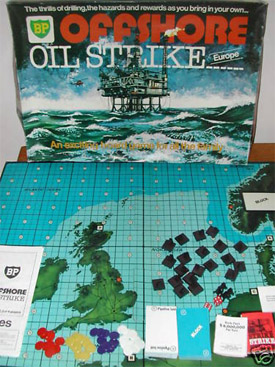
Holy cripes, this is actually real.
Average Rating: 4.9 out of 5 based on 218 user reviews.
July 14th, 2010 | Permalink
Tags: environment, fun

Arlington County and the Rosslyn BID are trying out a couple of new concepts in street furniture.
The loopy thing in the image at right is a new bike rack, intended to double as an attractive sculpture. After all, if Metro stations can double as works of art, why shouldn’t other pieces of infrastructure?
The boxy thing in the background isn’t so nice to look at, but is a nifty high-tech trash compactor. It’s solar-powered, compacts trash to reduce the frequency of collection (therefore reducing cost and pollution), and is secure against infestation by rodents and birds.
Of course trash cans and bike racks aren’t as sexy as new streetcars or defeated schemes to turn Washington into Houston, but they’re nonetheless important parts of the streetscape that contribute to good urbanism. Cheers to Rosslyn for progressively finding better solutions to everyday problems.
Average Rating: 4.7 out of 5 based on 204 user reviews.
July 1st, 2010 | Permalink
Tags: bike, environment, government, transportation, urbandesign

Spring 2010 was officially the warmest on record both for Washington, DC locally and Earth as a whole. In today’s post at the Washington Post Local Blogging Network, I make the point that whether or not humans caused it, warming is here, so we’ll have to do something about it.
Average Rating: 4.8 out of 5 based on 272 user reviews.
June 23rd, 2010 | Permalink
Tags: environment, washpostblog

|
Media





Site
About BeyondDC
Archive 2003-06
Contact
Category Tags:
Partners
|


